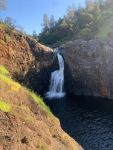June 21, 2018 - Bees, birds, butterflies, bats and beetles provide vital but often invisible pollination services that support terrestrial wildlife and plant communities, and healthy watersheds.
The bee marked in yellow is this hive's queen. There is usually only one queen in a hive, which the worker honeybees feed, follow, and protect.
(Credit: Marisa Lubeck, U.S. Geological Survey. Public domain.)
Bees are nearly ubiquitous, occurring on every continent except Antarctica. Wherever there are insect-pollinated flowering plants — forest, farms, cities and wildlands — there are bees. And just because you don’t see plants blooming, does not mean that there are no bees around.
There are nearly 20,000 known bee species in the world, and 4,000 of them are native to the United States. From the tiny and solitary Perdita minima, known as the world’s smallest bee, to the large carpenter bee, to the brilliant blue of the mason bee; native bees come in a variety of shapes, sizes and colors. And all these bees have jobs, as pollinators.
Native bees pollinate plants like cherries, blueberries and cranberries, and were here long before European honeybees were brought here by settlers. Honeybees are well known for pollinating almond and lemon trees, okra, papaya and watermelon plants. But native bees are estimated to pollinate 80 percent of flowering plants around the world.
According to the USDA, bees of all sorts pollinate approximately 75 percent of the fruits, nuts and vegetables grown in the United States, and one out of every four bites of food people take is courtesy of bee pollination. In sum, bee pollination is responsible for more than $15 billion in increased crop value each year.
But it’s not just bees!
The Indiana Dunes National Lakeshore used to be home to the Karner blue butterfly, a native pollinator that was listed as an endangered species in 1992. Scientists at the USGS surveyed federal parks along Lake Michigan in the late 1990s, and found more than 1,000 butterflies. Those numbers have been reduced to the point that only two were spotted in 2014. USGS scientists are at the forefront aiding the rehabilitation of the Karner blue in the United States, providing key information and science to decision makers.
Native to Hawaiian forests the ‘i‘iwi is a pollinator whose populations have severely declined in recent decades in Hawai‘i Volcanoes National Park (HVNP) and elsewhere in the Hawaiian Islands. Population decline is due to the cumulative impacts of many invasive threats that have degraded habitats, disrupted food webs, competed for resources, depredated nests and birds, and transmitted diseases.
Feral pigs and goats have been removed from important bird habitats within HVNP, but native vegetation is slow to recover from long-term damage from these species, and additional management is needed to prevent i'iwi from becoming extirpated.

The Hawaiian ‘I‘iwi, a native forest bird species only found in the Hawaiian Islands.
(Credit: Robby Kohley, None. Public domain.)
‘I‘iwi feed primarily on nectar, and some travel long distances to reach locally abundant sources. The USGS is providing the scientific information needed to understand the responses of ‘i‘iwi to nectar availability, which will help managers develop strategies for attracting ‘i'iwi from marginal or high-risk habitats and retaining them in protected areas. USGS scientists are also studying the response of ‘i'iwi to various floral nectars and the structure and composition of the vegetation, temporal availability of nectar across the landscape, quality of nectars, and the interactions of ‘i‘iwi with other nectar-feeding birds.
Want more pollinators?
You can read more on how USGS is providing science to better understand the status of pollinator species at USGS status and trends of pollinators.
Check out the USGS Native Bee Inventory and Monitoring Program, which designs and develops large- and small-scale surveys for native bees. As part of the program they also provide the first-ever comprehensive identification tools and keys for North American native bee species. Established in 2004, the program has made advances in bee monitoring, and developed and tested survey techniques that were incorporated into the bee manual, “The Very Handy Manual: How to Catch and Identify Bees and Manage a Collection.”
Read up on ‘I’iwi at: Evaluating ‘I‘iwi Responses to Nectar Availability and Habitat Quality
Source: USGS
Check out the story on Land-Use Change Rapidly Reducing Critical Honey Bee Habitat in Dakotas

















































































